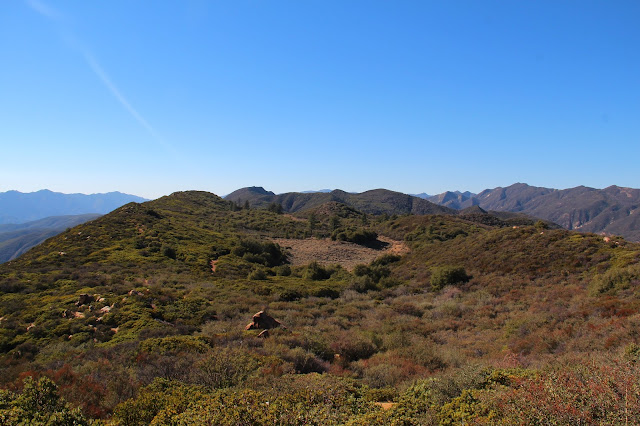 |
| The View North from Iwihinmu'u |
Mahk jchi tahm buooi yahmi gidi
Mahk jchi taum buooi kan spewa ebi
Mahmpi wah hoka yee monk
Tahond tani kiyee tiyee
Gee we-me eetiyee
Nanka yaht yamoonieah wajitse*
~Mahk Jchi (Heartbeat Drum Song)
Mt. Pinos sits among the butterscotch-scented Ponderosa pines in the high country where the transverse ranges begin to bleed into the Central Valley. At 8,831' in elevation, it is the highest point of Ventura County. As a result of this distinction, it has been leveraged by modern man like a number of other prominent Southern California peaks to facilitate modern communications. An unsightly radio tower adorns its hump-backed summit.
But those who came before us treasured Mt. Pinos for other reasons. To the native Chumash Indians who occupied this land for generations before the arrival of the Californios, Mt. Pinos, or Iwihinmu'u in the language of the Samala, was Liyikshup, the center of the world. This was a place of black bear and mule dear, of white fir and Jeffrey pine, of buckwheat and lupine, of Almiyi. This was a sacred place where life was in balance.
It's not difficult to see why the Chumash believed this. If you ignore the modern intrusions atop Mt. Pinos proper, and push on a short distance to the "Wildlife Viewing Area" to the immediate west of the summit, it is possible to experience the awe that the Chumash must have had for this place. The natural world has a distinct rhythm and hum. This hum is not audible. It is not visible. You can't feel it. But close your eyes. Be still here. The hum is very plainly present at the center of the world. The energy here is palpable.
Directly west of Iwihinmu'u, located in the aptly named Chumash Wilderness, sits Sawmill Mountain. The two are connected by the Tumamait Trail, named for Vincent Tumamait a Chumash spiritual leader and storyteller who passed in 1992. To get to Sawmill, follow the Tumamait Trail west as it drops gently off the shoulders of Mt. Pinos to a shallow saddle at roughly 8,400. The trail then regains the elevation just lost as it climbs to the broad, rounded summit of Sawmill Mountain at elevation 8,813'.
Unlike its slightly taller brother, Sawmill Mountain is not fouled with electronic equipment and other amenities. Instead, its summit is bedecked with a huge cairn made from flat stones that litter the area. And that energy you felt on Iwihinmu'u? That palpable natural hum that can neither be heard nor felt? Well its present here too, focused perhaps by the large spirit tower that masquerades as a summit monument. Sit quietly on this exposed summit. Listen to the wind. Absorb the expansive views north toward the San Emigdio Mountains and the flats of the southern San Joaquin Valley. Record your thoughts in the summit register hidden within the recesses of the monument.
Re-energized, retrace your steps through the numerous twisted and strangely contorted trees back to the large parking area at the terminus of Mt. Pinos Road where you began. Or continue west from Sawmill along the Tumamait Trail through the Puerta del Suelo to Campo Alto atop Cerro Noroeste where you can spend the night under the bright moon and diamond stars that adorn the evening sky above the center of the world. And like the Chumash, live a hundred thousand years.
Directly west of Iwihinmu'u, located in the aptly named Chumash Wilderness, sits Sawmill Mountain. The two are connected by the Tumamait Trail, named for Vincent Tumamait a Chumash spiritual leader and storyteller who passed in 1992. To get to Sawmill, follow the Tumamait Trail west as it drops gently off the shoulders of Mt. Pinos to a shallow saddle at roughly 8,400. The trail then regains the elevation just lost as it climbs to the broad, rounded summit of Sawmill Mountain at elevation 8,813'.
Unlike its slightly taller brother, Sawmill Mountain is not fouled with electronic equipment and other amenities. Instead, its summit is bedecked with a huge cairn made from flat stones that litter the area. And that energy you felt on Iwihinmu'u? That palpable natural hum that can neither be heard nor felt? Well its present here too, focused perhaps by the large spirit tower that masquerades as a summit monument. Sit quietly on this exposed summit. Listen to the wind. Absorb the expansive views north toward the San Emigdio Mountains and the flats of the southern San Joaquin Valley. Record your thoughts in the summit register hidden within the recesses of the monument.
Re-energized, retrace your steps through the numerous twisted and strangely contorted trees back to the large parking area at the terminus of Mt. Pinos Road where you began. Or continue west from Sawmill along the Tumamait Trail through the Puerta del Suelo to Campo Alto atop Cerro Noroeste where you can spend the night under the bright moon and diamond stars that adorn the evening sky above the center of the world. And like the Chumash, live a hundred thousand years.
*A hundred years have passed
Yet I hear the distant beat of my father's drums.
I hear his drums throughout the land.
His beat I feel within my heart.
The drum shall beat
so my heart shall beat


















































